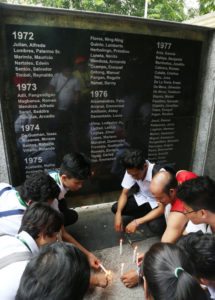IT HAS been 44 years since the declaration of Martial Law, but Albay Rep. Edcel Lagman still remembers September 21, 1972 and the atrocities that followed.
Lagman, whose brother Hermon disappeared during martial rule and was never found, said the anniversary of the late strongman Ferdinand Marcos’ Proclamation 1081 should not be celebrated.
But it should not be forgotten, either.
“We mark this date so that we will be reminded of the atrocities and plunder during Martial Law. This should never happen again,” Lagman said in an interview.
Records from the Task Force Detainees of the Philippines showed there were 6,295 unwarranted arrests toward the end of 1972 alone. This increased to 29,500 at the end of 1973 and 92,607 by the end of the Marcos regime in 1986.
The group also listed 5,531 cases of torture, 2,537 summary executions and 783 involuntary disappearances.
A September 1992 Hawaii Federal District Court decision ruled that Marcos was liable for human rights violations and the Marcos estate liable for damages, awarding $1.2 billion to human rights claimants on February 23, 1994.
On January 18, 1995, the jury of the same court awarded $755.4 million in compensatory damages, validating 9,074 claims.
Fight goes on
The fight goes on for the Lagman who is one of the petitioners against the Duterte administration’s plan to bury Marcos at the Libingan ng mga Bayani (Heroes’ Cemetery).
“We should not embark on a revisionist policy and changing our history,” Lagman said.
The scheduled burial of Marcos on September 18 did not push through because the petitions filed by Lagman and other Martial Law victims, such as former representatives Neri Colmenares of Bayan Muna and Etta Rosales of Akbayan, prompted the Supreme Court to issue a 20-day status quo ante order in August, which was extended until October 18.
In a forum at the University on Santo Tomas last September 19, Colmenares said Marcos’ burial in the Libingan ng mga Bayani would be unconstitutional.
“The Supreme Court, Congress and the Executive branch have declared public policy that Marcos was, first, a dictator; second, corrupt; third, a human rights violator,” he said in Filipino.
Duterte had authorized Marcos’ burial at the Libingan, citing regulations of the Armed Forces of the Philippines that allow former soldiers and presidents to be buried in the national cemetery.
Colmenares, a Martial Law victim, used Republic Act (RA) 289 as a counter-argument.
Section 1 of the RA 289 reads: “To perpetuate the memory of all the Presidents of the Philippines, national heroes and patriots for the inspiration and emulation of this generation and of generations still unborn, there shall be constructed a National Pantheon which shall be the burial place of their mortal remains.”
“Is he worthy of emulation and a source of inspiration?” he asked.
Zenaida Mique, also a Martial Law victim, recounted the abuses committed against her during the Marcos regime.
Mique, a grassroots organizer in the Ilocos region, was arbitrarily arrested in 1979 and detained at Camp Diego Silang in San Fernando, La Union until 1981.
“It’s not just an insult. It’s like rubbing salt on the wound. That’s how painful our experience is now, with the plan to bury Marcos at Libingan ng mga Bayani,” said Mique in Filipino.
No amount of money will ever be enough to compensate for the abuses done to Martial Law victims, Mique added.
UST History Department Chairman Augusto de Viana warned of young people who idolize Marcos, saying they downplay the dictatorship and erase it from history.
“The danger now is that the youth of today, they idolize people like Marcos and the collective memory about him is being erased,” de Viana said.
Claims unreleased
In a statement Tuesday, the “Marcos Presidential Center” claimed the Human Rights Victims’ Claims Board formed by Republic Act 10368 or the Human Rights Victims Reparation and Recognition Act of 2013, signed by President Benigno Aquino 3rd, had yet to release money to Martial Law victims.
The board has P10 billion in funding to compensate 75,730 victims, but has yet to finish processing claims, it said.
“Meanwhile, members of the board continue to get big salaries. And they will even build a P50-million Martial Law museum,” the center said in Filipino.
“It’s clear the Martial Law claimants are being used by heartless people to plant or spread hate in the minds and hearts of citizens, to keep open the wounds inflicted by Martial Law,” it added.
WITH CHRISTIAN DE LANO M. DEIPARINE AND MARIA CRISANTA M. PALOMA, CONTRIBUTORS



